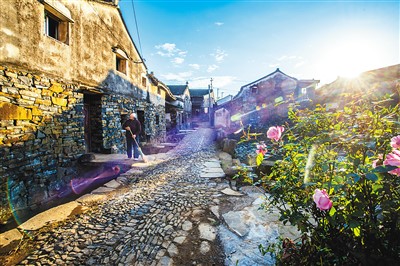
A view of ninghai "stone village".
Photo by Xu Mingyi
In the mountains in the east of Ninghai County, Ningbo City, Zhejiang Province, there is a "stone village". Winding stone alleys, quaint stone houses, babbling streams... The scenery of the ancient village is like a landscape painting like a paradise.
The "Stone Village", known as Xumin Village, has a long history and can be traced back to the Southern Song Dynasty. The local mountain is far away, the traffic is inconvenient, the stone on the mountain is hard, easy to use, the villagers will use local materials, masonry walls, stone houses, paving roads, building stone bridges, carved stone windows, stone mills, stone alleys... Most of the existing stone houses in the village were built between the middle and late Qing Dynasty and the Republic of China, and are made of black basalt stacks unique to the local area. Standing on the top of the mountain, nearly 300 stone houses are scattered along the mountain, undulating with the terrain, gradually rising from east to west, forming a unique scenery that is rare and rare, and has become a model of the mountainous stone house architectural community along the east coast of Zhejiang.
"There is an ancient road in the village, and in ancient times, merchants and passers-by had to pass through here, and the 'stone village' at that time was lively and prosperous." Dai Shenyi, secretary of the village party branch of Xumin Village, introduced that after the highway was opened, there were fewer people taking the Ningxiang Ancient Road, more people in the village went out to work, and many stone houses were also vacant. The village's economy was once in trouble due to factors such as labor loss, the houses were dilapidated, the environment was dirty, and the land was poor, and the "stone village" became a "three-more village" with many debts, contradictions, and single sticks.
In 2006, the new village team of Xumin Village took office, and the village party branch led the party members and the masses to practice the development concept of "green water and green mountains are golden mountains and silver mountains", overcame the difficulties of poor foundation, location bias, insufficient funds, etc., and embarked on a characteristic development path of "party building + tourism", and built the poor and white "stone village" into a leisure tourism area integrating mountain village experience, cultural exchanges, convalescent vacations, leisure sports, entertainment and shopping. Tourists are coming, young people who have gone out are also coming back, and life in the village is getting hotter and hotter every year. "Stone Village" has been successively selected into the list of famous historical and cultural villages in China and the list of traditional villages in China. In 2021, the number of tourists in scenic spots exceeded 500,000.
Walking in the "Stone Village", the mountain wind blows through, bringing the fragrance of flowers and grasses and soil, and the crisp and pleasant wind chimes are heard from time to time in the eaves. According to the prestige, it is the newly renovated "Yuexiang Hall" and "Ishimura Porcelain Factory" in the village. This is another exploration of the scenic spot on the protection of ancient buildings and the inheritance of intangible cultural heritage, the two emerging tourism formats are transformed from ancient buildings in the village, the former is characterized by ancient incense, which can be used by tourists to experience the production of incense, incense pills, incense pieces and other crafts; the latter is characterized by porcelain-making experience, using porcelain mines unearthed in Chayuan Township as raw materials, using grass and wood on the mountain to refine porcelain glazes for tourists to enjoy.
In Xumin Village, it is not uncommon for tradition and modernity to blend together. The old tea factory and broken cowshed in the 50s at the mouth of the village have also been changed into casual restaurants and bars in accordance with the concept of "repairing the old as old", and have become the net red punch point of "Stone Village".
There was everything you needed for food and lodging in the village. The "twelve bowls of peasant dowry" is enough to make tourists eat their fingers. This is a special menu for local villagers to do weddings, birthdays, spring and other banquets, because it has twelve bowls of main dishes and named, mostly using pigs, chickens, ducks, fish and homegrown vegetables, melons and fruits as raw materials, is the "living fossil" of the mountain festival culture along the coast of Zhejiang. The mountain b&B group can be used for tourists to stay, the white-walled Dewa is reflected in the green grass and green trees, waking up to clouds and mist, birds singing and chirping, and there are hot spring pools to relieve the fatigue. Not far away, 80% of the area is covered by lawns and greenery, and the mountain scenery can be viewed on a day and the stars can be enjoyed at night.
The Qing Dynasty poet Xu Yong wrote in the poem "Crossing Xujia Mountain": "The jackal crouches on the road, and the secluded path goes around the cold mountain." Infinite oblique sun color, to add frost leaf Yin. Autumn sky carvings are strong, and stone hooves are stomped. Deeply envious of the guest in the clouds, shoulder to shoulder tree to go back and forth. "Walking in this stone house ancient village, you can still feel empathy with the ancients." (Zhang Chenyi)
Source: People's Daily Overseas Edition